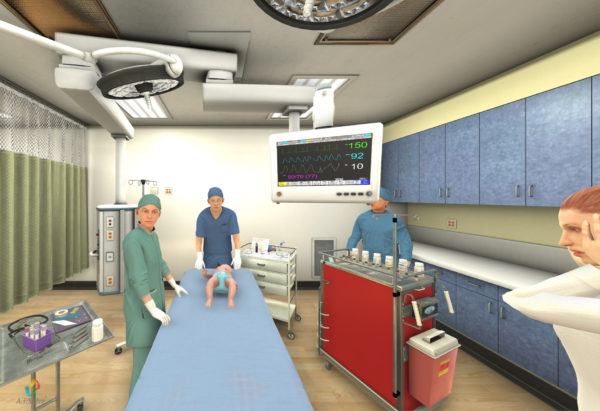Games, training and education; the innovative technology of AiSolve
One of the early pioneers in virtual reality technology, Devi Kolli, co-founder and CEO of AiSolve, explains that her company does not see VR as new – “to us, it’s tried and tested”. Because not only are they in existence for 10 years now – a rare achievement in this sector of start-ups – not only were they one of the original companies to deploy VR content, they have also invented their own patented VR hardware to do this.
Describing itself as an Artificial Intelligence solutions provider, bringing together the best in AI, VR & MR products and solutions, AiSolve operates two distinct strands in its day-to-day business – out of home entertainment alongside training and education. “Artificial Intelligence is embedded in all of our applications in both of these sectors, but it is stronger in our training element,” Devi explains.

Interestingly, in a gaming sector known for its strong VR growth and exciting trends, Devi doesn’t see this as the heart of their business. “VR is leading in the world of gaming and in the last 18 to 24 months, there has been a big step change in terms of both the investment in and market for VR hardware. It’s clear that there is a lot of interest focused on the gaming element of VR and it’s a no-brainer to use the technology in this way. But at AiSolve, we don’t believe that VR will be a big component of gaming, either in home entertainment or in out-of-home experiences.”
Instead, this market will remain relatively niche but very stable in its current forms – both large room experiences for groups and smaller pop-up arcade-style games. There is of course, she agrees, a definite market for VR in this sector but there is also a need for education within this market – not just for audiences but also for the producers who are moving in to this area.
Working in the games sector: what’s the technology?
In its out-of-home entertainment business, AiSolve is catering for the pop-up, arcade-style market. In its WePlayVR product, with a small footprint taking up 3×3 m2, audiences pay £5 for a four-and-a-half-minute virtual reality experience, solving puzzles as they progress through the game to access new areas.
WePlayVR has been critically acclaimed in the market, described by Road to VR, one of the leading independent magazines for the consumer VR industry, as a low-cost way for family entertainment centres to bring VR experiences to their customers. Everything comes in one box, from the VR headset to the bespoke content and software, and it has been heralded by Road to VR as providing a very high level of immersion.
“I completely forgot where I was within the pod, or even that I was confined to a square space. When I was standing on the moving platform, which, virtually, was open on all sides with a cavernous drop below me, I very well could have actually been in the corner of the pod with walls on either side and I wouldn’t have known. By the time I was ready to take off the headset, I would have been hard pressed to guess where specifically I was standing in the pod, or even which direction I was facing.”
— Road to VR
The magazine also predicts a bright future for the company’s forthcoming games; “It’s clear to see that with each game project the content is becoming more ambitious and AiSolve is learning how to design around the available space with even more trickery to make players feel like they’re somewhere else entirely than in the confines of the pod.”
This was always the intention. “Taking virtual reality into a typical gaming environment and just using it to shoot things is not using the full impact of this immersive technology, and not maximising its benefit,” acknowledges Devi, explaining that they wanted to shake up the content market for games. “We find that certain games fail because they are over complicated, their operation makes them very technical and there are too many interactions. We create games that anyone can play.”
The pop-up arcade WeplayVR comes with a spectator portal to run real-time game footage, which provides a tantalising taster to the crowd watching but preserves the thrill of playing the game for the first time by cutting away at dramatic moments so as not to ruin the surprise or provide answers in advance to the games’ puzzles. Not only does this build the excitement and promote the game to a wider audience, it is also commercially strategic as it provides openings to sell advertising space to monetise the original investment for the supplier.
Constantly refreshing the content is also important to their ethos – she describes their approach as “Netflix for VR” – and they are committed to providing new titles every quarter. Since launch in April 2017, three titles have already been released for the technology and next steps include creating open catalogues for other developers to access.
What impact has it had on the sector?
Writing in VR Focus, industry specialist Kevin Williams, founder and director of the out-of-home leisure entertainment consultancy KWP Ltd, selected it as one of his top picks at the 2017 European Amusement and Gaming Expo (EAG).
He says: “AiSolve and their WePlayVR platform offers a great approach – the virtual maze style enclosure comes with the limitations of one player at a time, compared to some arena-scale VR systems, but also fits a footprint that allows the system to be deployed in a wide selection of entertainment venues. The company has managed also to create a library of titles that can be compelling to those new to VR.
Speaking of the impact AiSolve has had on the out-of-home entertainment sector in general, Kevin adds: “The ability to bring a new perspective to the implementation of immersive entertainment is what is driving the current interest in VR, and beyond the restrictions of home usage, the ability to deploy an effective platform in the out-of-home entertainment arena is driving many advances.
“It is expected that the VR enclosure approach to immersive platforms will expand, with these systems used in-conjunction with other stand-alone VR pieces, or in clusters. For the time being this phase of VR adoption seems to find backpack based free-roaming experiences more than compelling than the alternative.”
VR in training and education
However, it’s in the training and education sector that Devi predicts the greatest growth and here AiSolve is focused on bringing Artificial Intelligence to the market. Describing a recent project, where medical professionals were trained in emergency room techniques when treating children in life or death situations, she explains that VR technology can make this experience as realistic as it can possibly be.
“In these situations, medical professionals are making split second decisions that can be the difference between life and death. They are highly stressful situations and it may be a scenario where distraught parents are also in the room. If the professional has encountered this type of situation before, they may be able to base those decisions on previous experience, but if there has been no previous experience, then that’s what we can provide.

“We can replicate the emergency room with VR technology, using both visual and audio recreations. AI technology can be used to respond to user reaction so that it reacts differently to each user, as it is responding to their individual actions. In the back end, AI is used to be predictive and to record the data that is being accumulated.”
The VR simulation was designed in collaboration with doctors at the Children’s Hospital in Los Angeles, in conjunction with Oculus’s VR for Good programme and a company called Bioflight who provided the visual effects. One of the doctors involved in the development of the training package, Dr Joshua Sherman of CHLA and the USC Keck School of Medicine, explains that VR has helped to solve several problems for medical training programmes.
Hands-on training for medical students and residents is both time-consuming and expensive and requires a lot of resource in putting highly skilled medical professionals in place to conduct the training. While screen-based training can minimise the issues involved, it is not as impactful in creating the type of real-life emergency situations the students will encounter.
What technology does it use?
The technology used in AiSolve’s applications has been created by the company’s team of in-house experts, based on an application called Global Artificial Intelligence Application (GAIA) which they describe as a platform crafted to meet a growing global demand for intelligent and responsive VR and MR content. They also use standard game engine technologies, Unity and Unreal, but have created their own software on top to provide truly bespoke offerings for the market.
Acknowledging that their impact in the VR industry has been substantial, Devi adds that we’re now in the third big life-changing wave of technology, which started with the growth of the internet and continued with the coming of the smartphone. Wave number three will be VR and wearable tech, she predicts, while conceding that in the area of smart glasses, for example, the technology needs to improve before we start seeing them on the street.
While VR is still not as strong in training and education as it is in gaming, she predicts that it will grow into a strong platform in this sector, which is bound to become mainstream at some point. In a sector that works on the basis of evidence-based material, VR in training is already gathering the evidence to prove its potential value benefits and the results that it can drive to trainees, institutes and enterprises. Because when it comes to training, it is generally the evidence-driven products that have better market penetration.
Investing heavily in R&D in the company’s early years has paid off she reveals and their investments in VR technology in recent years has already brought about company growth of 300%.
And what does the future look like in this space?
“I believe VR in training and education is about to hit the mainstream,” Devi says. “We’re already starting to see the advent of VR classroom suites and this is something I am working on with local authorities, universities and colleges, with the aim of launching more of these institutions.” She also predicts that mixed reality will start to become more important in this space in the future, pointing to the fact that Pearsons and Microsoft HoloLens are already targeting it.
It is the AiSolve belief that Artificial Intelligence, VR and MR will transform the way we live, work and socialise, significantly impacting the global enterprise and consumer landscape. Developing new applications in this space is a must to stay relevant, engaged and competitive.
Words: Bernadette Fallon